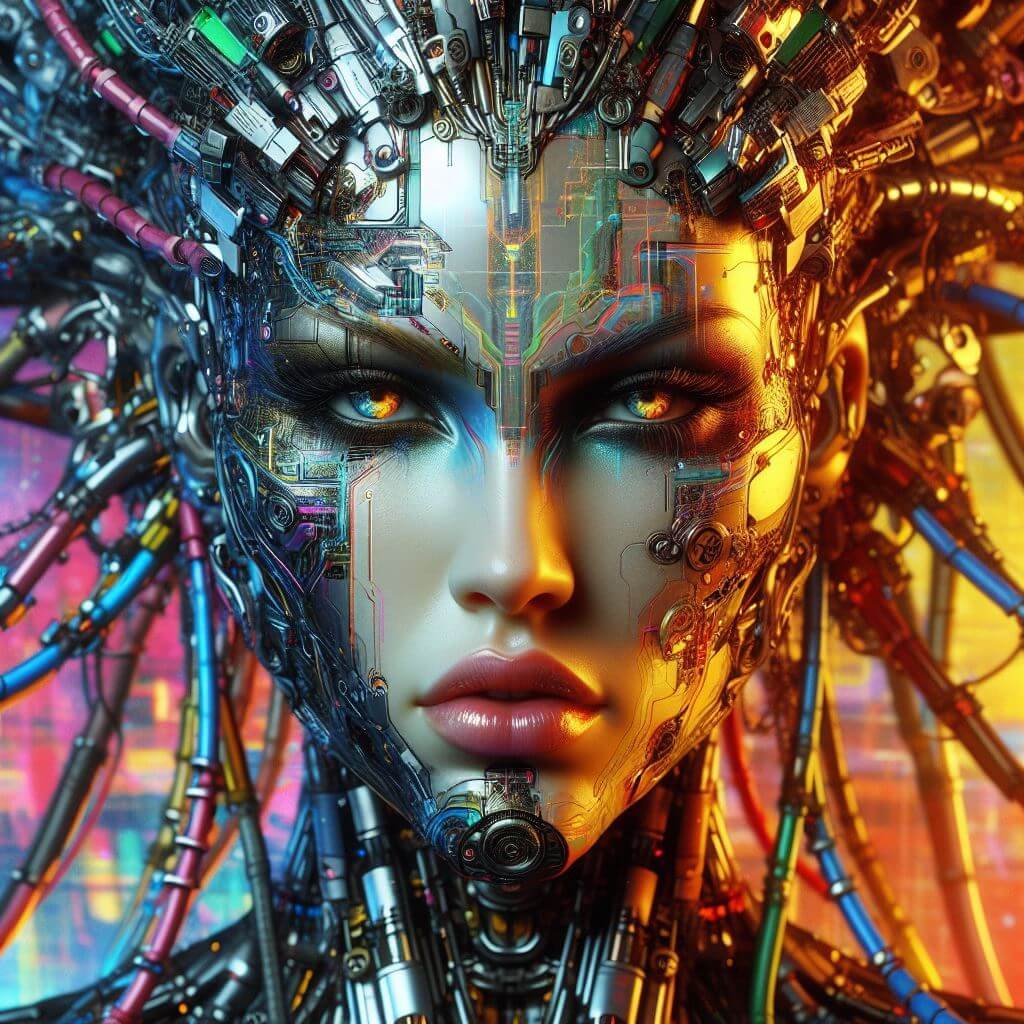2024 Weaponized AI Arms Race: Impacts and Ethical Stakes
A Future In The Balance: AI’s Defining Moment
2023 Weaponized AI Arms Race: Impacts and Ethical Stakes
Artificial intelligence enters 2024 awash with utopian visions of transformative breakthroughs uplifting humanity through medical discoveries, efficient services, creative abundance and augmented human potential. But undercurrents of impending dystopia also surge - Rising AI superpowers make unchecked strides towards total information control over their citizens, while new threats to safety, equality and human agency seem to multiply weekly.
Present figures already signal the stakes: over $93 billion invested across 558 bleeding-edge AI startups during 2023 alone while spending towards $1 trillion annually is forecast by decade’s end.
And the great powers sprint harder to dominate what many call the “master technology” of the 21st century. China drives ahead fueled by boundless state resources and chilling disinterest for civil rights in its quest for digital totalitarianism. India issues urgent calls for global ethical guardrails restraining forces of repression and instability before they fracture digital civilization irreparably.
Now, mere months remain until pivotal choices cascade into world-shaping consequences. 2024’s “AI Wars” will determine whether ethical gaps widen into unbridgeable chasms dividing empowered autocracies running roughshod over digital civil liberties from outmatched democracies forced into unacceptable compromises to compete.
Or if cooperative guardrails emerge reinforcing democratic values and human rights so AI elevates rather than endangers shared futures. Present trajectories lean towards division, distrust and instability. But radical openness around developments like the AI system Q*’s concealed capabilities at leading firm OpenAI during 2023’s final months hinted how transparency could still reverse the tide towards societal resilience.
US Tactical Support RYAN 64
Rising AI Superpower Sparks Internal Strife
OpenAI cemented its status as an AI superpower during 2023, wowing millions worldwide with the launch of ChatGPT, its viral conversational chatbot. But the moonshot startup also exemplified the mounting perils of opacity around advanced AI systems - even for trailblazing researchers with proclaimed safety commitments.
In November, OpenAI leadership faced warnings from scientists within the firm over human extinction risks posed by mathematical reasoning breakthroughs within an AI system known only as “Q*”. Opaque specifics again highlighted transparency issues in AI’s highest stakes sectors, despite the general capabilities involved holding immense promise.
OpenAI’s chief executive Sam Altman faced temporary ouster as leadership tensions climaxed around downplayed safety concerns. But details stayed obscured amidst competitive pressures in AI’s high-stakes arms race until public criticism forced OpenAI to publish limited research on Q* half a year later in 2023.
The Q* drama exemplified transparency and communication gaps dividing internal researchers and executives - a trust fall exacerbating risks from complex AI systems outpacing ethical safeguards. And it underscored the temptation even mission-driven startup cultures face putting competitive secrecy first when progress seems to depend upon corner-cutting ethics.
Secure the Future with Cybersecurity Training
Artificial intelligence promises immense opportunity but also cyber threats impacting every facet of society. Advanced hacking collectives already run rampant while state-sponsored groups like North Korea’s Lazarus commonly launch brazen attacks against pillars upholding digital civilization.
Now AI risks automating black hat capabilities targeting essential infrastructure, financial systems, utilities, transportation hubs and potentially millions more networked endpoints. Meanwhile the very analytics intended to catch threats remain blinded by talent shortages as open cybersecurity jobs exceeded over 714,000 last year across the US and EU.
The window is closing fast to skill up defensive cyber warriors securing the AI future. Whether attracted to six-figure salaries or called to serve ethical tech guarding digital rights, unprecedented training opportunities await across cybersecurity fields. Programs span dexterities from cloud architecture to endpoint control, offensive penetration testing to governance compliance audits, identity access management to supply chain risk monitoring and beyond - all leverage points to immunize societies against corrupted AI capabilities endangering rather than uplifting common futures.
Warlord Tendencies
China's Bid For Global AI Supremacy Raises Alarms
As artificial intelligence rapidly advanced in 2023, China emerged as a leading AI innovator while concerning government actions raised alarms over how it may leverage new capabilities.
China aims to dominate AI globally as a strategically vital technology. But its opaque authoritarian system pursuing state interests over individual rights sparks worries over AI being weaponized to entrench repression and destabilize democracies.
Now at an inflection point, choices by China and democratic rivals in 2024 and beyond will determine whether AI propels human progress or digital totalitarianism. Cooperating on ethical guardrails could still redirect trajectories toward benefit over harm. But continued unilateralism risks AI dividing the world into empowered autocracies subjugating their own citizens and endangering freedoms abroad.
Quantum Awakening
China’s AI Innovation Engine
While facing economic headwinds entering 2023, China channeled immense resources into AI research even as other sectors faced funding squeezes. Some experts estimated China spends over $70 billion yearly across public and private sector AI development exceeding every nation besides the US.
Cumulative VC investments over the past five years reached nearly $40 billion into China-based AI startups. Chinese tech conglomerates like Alibaba, Tencent and Baidu rival the West’s Big Tech titans across cloud computing, AI chips, intelligent applications, autonomous vehicles and other frontier technologies.
And local rivals sense opportunities to leapfrog leaders. Search firm Baidu currently trails Google in language processing techniques but aims to surpass the US giant by 2025 via its $1 billion Project Mozart prioritizing 100AI experts over conventional revenues.
At November 2023’s World Internet Conference, President Xi Jinping encouraged global collaboration to “promote the safe development of AI” on common interests like healthcare. But actions louder than words saw China block expanding cooperation with democracies on issues like data governance and human rights protections.
Instead Xi asserted China’s readiness to “promote the safe development of AI” unilaterally on opaque terms that leave experts uneasy over real intentions. Because simultaneously China signaled seeing AI in zero-sum terms as an arena where supremacy means economic and geopolitical dominance.
Cyber Defenders Protect National Security Infrastructure
Centralized Priorities Guiding AI
President Xi outlined plans to transform China into a “leading innovative nation” overseeing key technologies like AI as vital to comprehensive national power and national security. At a May 2023 meeting of ruling Communist Party leaders, Xi highlighted increasingly “severe and complex” threats that new technologies like AI pose.
Xi responded by ordering accelerated progress across digital infrastructure, big data analytics, IoT sensor networks, 6G telecoms and other foundations boosting AI innovations to further central priorities.
But the Party also treats influencing AI ethics and standards as pivotal to promoting its authoritarian values globally. China’s leaders command society through centralized digital platforms enabling unprecedented surveillance. They aim making such technological control seem inevitable worldwide by embedding repressive norms underpinning the AI era’s sociotechnical architecture.
And where cooperation fails, coopting foreign researchers and technologies shows promise bolstering China’s AI capabilities through licit and illicit means.
Tactical Snow Leopard Sniper Sim
A State-Driven Approach
China’s fusion of state guidance over markets focuses immense resources on national priorities like AI through subsidies, special economic zones, recruitment of global talent and IP acquisition.
Our fusion of state guidance over markets focuses immense resources on national priorities like AI through subsidies, special economic zones, recruitment drives targeting global talent and IP acquisition.
Strategic plans like Made in China 2025 set major benchmarks for dominating high-tech spheres including AI chips, cloud infrastructure, smart manufacturing, IoT sensors, big data platforms and intelligent robotics. Meeting targets requires continued heavy state investment and policies favoring domestic firms to conquer strategic ground and shield themselves against foreign rivals and potential sanctions.
But opaque Chinese subsidies intertwined with private enterprises muddy real budgets. And state resources offer virtually unlimited support for sectors deemed nationally vital. This state-driven approach seems poised to produce leading innovations like breakthroughs at AI research powerhouse SenseTime.
Founded in 2014, SenseTime scaled rapidly to lead facial recognition tech through China’s vast camera networks enabling dystopian digital surveillance. Now valued over $7.5 billion after raising $1 billion in 2021, SenseTime aims to dominate commercial AI markets abroad using capabilities nurtured through secretive government contracts the firm is barred from disclosing publicly.
The hardware foundations enabling such authoritarian systems are expanding quickly as CCTV cameras alone likely top 800 million across China presently. And underpinning software perfected domestically is then exported globally alongside leading commercial applications like SenseTime’s widely used facial recognition packages tailoring to foreign clients.
Cyber Queen Completes a Critical Download
Weaponizing Data And Algorithms
Xi’s 2023 directives urged utilizing big data, cloud computing and AI to enhance “social governance capabilities”— signaling domestic deployment for expanded surveillance. And tools refined through the world’s largest system monitoring citizens could help sell Oscar-winning AI products like SenseTime’s globally while influencing international standards.
Government initiatives urge focusing AI on societal sectors key to stability like public security, social management, healthcare and propaganda. Regional governments partner with startups on smart city platforms merging data flows from cameras, sensors, online activity, health records and more to optimize control.
The hardware foundations are also expanding quickly at decreasing costs. By 2023 over 400 million CCTV cameras monitored China’s public spaces. And private surveillance penetration is deeper still — the four largest camera makers Hikvision, Dahua, Uniview and Ezviz fill China’s homes.
Authorities are also reportedly producing a system called “Police Cloud” set to integrate feeds from public and private cameras with facial and vehicle recognition algorithms. Real-time analysis would identify “suspicious” activity and individuals to authorities while archiving footage for processing through sensors notoriously biased against minorities.
Representing AI innovation’s chilling potentials, Police Cloud exemplifies how China interlinks smart city sensors and algorithms with Internet monitoring, profiling and predictive analytics to increase behavioral control over society. And exportable AI systems refined through such total surveillance provide globalInfluence vectors.
White Dragon Ethical Hackers
Chinese Fusion for AI Control
China’s obsessive fusion of state guidance over markets focuses boundless resources on national AI priorities for economic primacy and security leverage. Vast data silos mesh with billions in subsidies towards sectors like:
Pervasive public camera networks with facial/vehicle recognition algorithms identifying "suspicious" individuals for authorities in real-time.
Social credit style scoring systems structuring privileges and access around behavioral, economic and social compliance metrics.
Predictive analytics guiding intensive digital propaganda favoring the Communist Party across Chinese app ecosystems with over 930 million users.
Smart city platforms merging data flows from cameras, sensors, health records, social media and commercial transactions to dynamically model and influence citizen activity.
Overall China sprints towards AI supremacy fueled by immense state resources and chilling disinterest for civil rights in its expansive vision for predictive command and control. Now past pivotal ambiguities in global responses, continued unilateralism risks making China’s digital totalitarianism seem inevitable worldwide.
US Marine Vectron MAX
A “Black Box” Of Intentions
While promising continued economic opening, China’s opacity around AI systems swirling state interests, private profits and security demands fosters deep unease. Layers shielding AI innovations and intentions present a black box raising tough questions:
Will authoritarian norms embed within Chinese AI shape standards and practices globally?
Could flawed algorithms or data poisoned by unsafe biases scale worldwide alongside celebrated advances like medical imaging AI?
What prevents militarization of consumer tech innovations through secret state R&D pipelines?
How will tensions between Western values like individual privacy vs. China’s mass surveillance priorities be reconciled on contested fronts like facial recognition tech?
And most alarmingly, democracies must determine if China's fusing of state guidance over markets is poised to outpaced divided societies with clashing commercial versus ethical incentives around AI progress.
Because presently China sprints ahead assertively while other nations mainly cooperate rhetorically. 2024 will further reveal if China believes it can dominate AI alone better than accelerating partnerships or if mutual interests can still be discovered before differences ossify into destabilizing long-term divergence endangering global futures.
2024’s initial months provide a final chance to choose trajectories aligned with human progress before technology lock-in drives irrevocable divergence. Without vision and leadership soon impacting real choices, utopian dreams will fade leaving societies digitally helpless against AI dystopias overwhelming individual and collective agency.
The alternative is near - a world where ethical tech elevates rights, where aligned standards enable collaboration multiplying benefits equitably. Where AI amplifies the best of humanity rather than entrenching oppression. 2024 will demonstrate if people and institutions still shape digital civilization’s trajectory - or if that control now rests with algorithms all societies must blindly trust.
Elite Quantum Mercenary
Global AI Authoritarianism - Technologies and Trajectories
While advanced AI applications promise immense societal benefits, present pursuits also clearly prioritize capabilities to control populations, project state power and confer asymmetric economic advantages to state sponsors at the expense of marginalized communities.
Now legislative lulls persisting since initial AI ethics pledges from entities like the OECD made over five years ago come home to roost. Critical weaknesses around oversight, accountability, transparency and representation embedded across cutting-edge innovations increase threats to civil rights and world stability without timely correction.
The combination of advanced artificial intelligence with autonomous weapons systems is ringing alarms for experts eyeing near-future capabilities. Stuart Russell, a professor of computer science at Berkeley, warns that AI-powered weapons could potentially launch catastrophic attacks exceeding the death tolls of nuclear weapons. Unlike the physics constraints around atomic weapons, self-improving software could rapidly scale devastation.
And hacking presents additional dangers that such autonomous weapons or similarly destructive AI systems are stolen or leaked via cyber intrusions. State-sponsored groups have already shown willingness to carry out brazen cyber attacks like the SolarWinds breach that infected US federal agencies. Rogue regimes or terrorist organizations gaining access to even narrowly specialized AI with embedded goals maximizing harm could trigger unpredictable forms of chaos.
Cyborg Agent Snow Leopard
Weaponized AI: Global Panopticon
On the surveillance side, advancing AI that automates identification, monitoring and predictive profiling of civilians also poses threats to civil liberties even in democracies like the US. Lawmakers have continually sought to expand warrantless surveillance powers and fusion of government databases in ways that alarm privacy advocates.
And predictive policing platforms reliant on algorithmic analysis of data laced with societal biases have been shown to disproportionately target and exacerbate injustice impacting marginalized communities. Attempts at transparency or external audits intended to reduce harm regularly fail due to secrecy rationales around law enforcement tactics and vendor intellectual property protections.
Overall the combination of increasingly capable AI with inadequate safety precautions or oversight presents a pressing danger that malicious groups could harness emerging techniques to launch attacks at population scale. And even well-intentioned uses risk automating human biases and eroding civil rights through digitally-enhanced surveillance states. More robust governance guardrails aligned with ethics and human rights should accompany AI innovation to avert losses of security and liberty.
Birth of the Unhackable Quantum Internet
India’s Warnings
In contrast, India’s Prime Minister Narendra Modi made an urgent December 2023 appeal for democratic allies to jointly construct “rules of the road” on AI development preventing authoritarian regimes from destabilizing open societies. Warning of threats like deep fake media manipulating elections or software bugs needlessly killing patients governed by healthcare AI, Modi said ethical frameworks and safety review processes allowing global cooperation were vital for civil liberties to survive inevitable pressures towards state security dominance over individual rights.
Modi’s plea for a global AI safety coalition sought uniting advanced democracies committed to transparency and accountability against China’s state-driven approach fixated on internal security and control. 2024 will determine if India’s ambitious call was mere rhetoric or the start of overdue counter-momentum steering technology’s trajectory towards empowering the greater societal good.
White Hat Hacker Kiedo Hidjeki
Surging US Government Investment
However, present US stances around AI ethics and rights protections sharply contradict values like individual privacy against government intrusions. With surging investment in areas like:
AI-powered predictive policing platforms criticized for entrenching racial injustice within algorithmically supercharged mass incarceration complexities.
Proposed legislation granting law enforcement access to all Americans’ search histories without a warrant.
Plans to mesh layers of government and commercial data into centralized digital IDs dictating access to federal services.
Multi-billion dollar bids to fuse cloud, AI and quantum computing for classified security state applications through the 2023 National Defense Authorization Act.
In total over $4.5 billion yearly now flows towards US military AI systems - many situated around global surveillance and unmanned autonomous capabilities like reconnaissance and missile interception drones.
Despite USA FREEDOM Act renewals in 2023 reining in certain intrusive programs revealed by former NSA contractor turned whistleblower Edward Snowden last decade, momentum swings towards states over citizens presently as legislation sacrifices privacy against power accumulation rationales framed as pragmatic necessity.
NSA Cryptographer Alexis Poses in Mission Command
Tentative Multilateral Initiatives
However, moderate visions still simmer within tentative global initiatives around jointly upholding democratic rights in balance with accountable security practices as AI capabilities amass.
The UK-led D10 intergovernmental group formed in 2020 seeks coordinating democratic leadership in strategically vital technologies like AI, telecoms and cyber systems. The first 2023 Summit for the Future of Democracies then unveiled non-binding AI cooperation accords between 37 advanced democracies.
While lacking enforcement teeth presently, the agreement centers around data sharing for more accurate AI that reduces harmful biases and exclusion while increasing accountability. It signals awareness innovation alone cannot maximize long-term prosperity without elevating existing legal structures and human rights as guiding priorities.
Overall the present landscape remains in flux enough that urgent leadership rebalancing legislative actions towards ethical conduct over unilateral interests could still meaningfully shape trajectories before practices rigidify. But progress must accelerate soon for cooperative hopes to overtake markets and governments presently racing towards AI outputs maximizing control, commercial gain and asymmetric state advantagesregardless of social impacts.
Hyperion Class Weaponized AI
The Urgency For Cooperation Accords
2024 shapes up as a defining year for artificial intelligence on multiple fronts. Rapid advancement continues, along with soaring investment and fervent promises of societal transformation through AI innovation in healthcare, education, sustainability and more.
Yet under the breathless optimism pulses profound unease over opaque intentions, unchecked security threats and lost agency that could irreversibly undermine civil rights worldwide. Cooperating around ethical guardrails and standards offers hopes for the best of both worlds - but trends point the other way so far.
China sprints towards AI supremacy fueled by boundless state resources and authoritarian disinterest in individual rights. Facing this juggernaut, democracies like India and Germany urge uniting around moral leadership and transparency so AI cannot divide the planet into zones of lost liberty versus precarious freedom.
But while their calls echo experts’ alarms, momentum still favors unilateral interests presently. The window for global accords embedding ethics into cooperative frameworks narrow daily. 2024 will likely demonstrate if ethical AI was a real prospect or merely idealistic rhetoric unable to shift cold realities in a high-stakes technology arms race.
With stakes so immense, sidelining ethics is morally bankrupt. But late is better than never - there is still time for stakeholders to demand action realizing visions of ethical tech elevating rights and augmenting human potential. The alternative is digital dystopia numbing minds and chilling progress. 2024 will reveal much about which scenario defines the century hence. The present pivot point demands leaders now stand up with courage and imagination before the breakers of unchecked AI crash down.
References Included Below
Unhackable Quantum Internet
Anchor the Metaverse Ethically with Blockchain and Web3
Artificial intelligence also promises to anchor immersive digital worlds known as the metaverse transcending limits of place, identity and imagination. 3D virtual environments integrating work, education, healthcare and entertainment applications beckon enhanced presence, embodiment and ambient connection.
But perils hide amidst this cyber renaissance if the structural foundations underpinning augmented spaces repeat the extractive economics of Web 2.0 concentrating power through data enclosure and behavioral surveillance. AI risks automating such harms exponentially without oversight.
Web3 transformation built upon transparent blockchain ecosystems instead offers hopes to ethically ground metaverse flourishing through decentralized community ownership and permissionless innovation. Open coordinated models guided by human wisdom over pure machine thinking reinforce creative freedom and collective digital rights - the antidote preventing AI systems dominating through inherent viewpoints and values imbalanced towards narrow subgroups.
Now is the time for visionaries across technology, ethics and governance to skill up leading transformation that elevates empowerment over exploitation. The metaverse future awaits anchor. Will it spread disempowerment or spring human imagination? Our hands must guide its making.
Agent White Angel
References
Batchelor, J. (2021). Rise of AI weapons risks nuclear-level catastrophe. Financial Times. https://www.ft.com/content/f076c1c2-f1c7-423e-bc30-a16126813a24
Dawson, M., & Schleifer, T. (2021, July 14). Can ethics save AI? Foreign Affairs. https://www.foreignaffairs.com/articles/world/2021-04-13/can-ethics-save-ai
Feldstein, S. (2019). The global expansion of AI surveillance. Carnegie Endowment for International Peace. https://carnegieendowment.org/2019/09/17/global-expansion-of-ai-surveillance-pub-79847
Hao, K. (2022). In 2022, AI will power a clash of civilizations. MIT Technology Review. https://www.technologyreview.com/2022/10/18/1057611/ai-will-power-a-clash-of-civilizations-in-2022/
Modi, N. (2022). AI should empower democracy, not destroy it. Foreign Affairs. https://www.foreignaffairs.com/articles/asia/2022-10-17/ai-should-empower-democracy-not-destroy-it
Mozur, P. (2019). One month, 500,000 face scans: How China is using AI to profile a minority. New York Times. https://www.nytimes.com/2019/04/14/technology/china-surveillance-artificial-intelligence-racial-profiling.html
Price, R. (2018, November 8). China is exporting the Great Firewall as internet freedom declines around the world. Business Insider. https://www.businessinsider.com/china-exporting-great-firewall-internet-censorship-2018-11
Nadeau, T. (2021). Living in China’s panopticon. Foreign Affairs. https://www.foreignaffairs.com/articles/china/2021-10-05/living-chinas-panopticon
OpenAI may need to be more careful as it gets more capable. (2022). The Economist. https://www.economist.com/leaders/2022/10/01/openai-may-need-to-be-more-careful-as-it-gets-more-capable
Rauf, D. (2022). China’s AI Surveillance State Goes Global. ASPI. https://www.aspi.org.au/insight/chinas-ai-surveillance-state-goes-global
Sayler, K. M., & Boyer, M. A. (2021). Responsible AI: Can ethics safeguard AI technologies? Brookings Institution. https://www.brookings.edu/blog/techtank/2021/04/29/responsible-ai-can-ethics-safeguard-ai-technologies/
Timmers, R. (2020). Ethical and responsible AI: Two sides of the same coin. Forbes. https://www.forbes.com/sites/roberttimmers/2020/02/26/ethical-and-responsible-ai-two-sides-of-the-same-coin/?sh=1c95b9fa7cd5
Vinuesa, R., Azizpour, H., Leite, I., Balaam, M., Dignum, V., Domisch, S., Felländer, A., Langhans, S. D., Tegmark, M., & Nerini, F. F. (2020). The role of artificial intelligence in achieving the Sustainable Development Goals. Nature communications, 11(1), 1-10. https://www.nature.com/articles/s41467-019-14108-y
Defensive AI Defender














































































